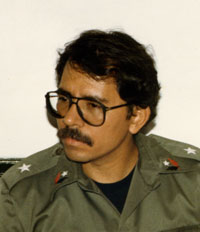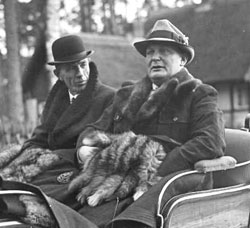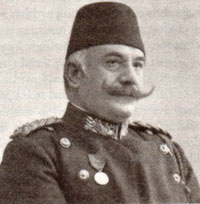This week in history: November 19-25
19 November 2012
This Week in History provides brief synopses of important historical events whose anniversaries fall this week.
25 Years Ago | 50 Years Ago | 75 Years Ago | 100 Years Ago
25 years ago: Sandinista regime releases Contra prisoners
 Daniel Ortega
Daniel OrtegaOn November 22, 1987, the Sandinista government of Nicaragua released 985 prisoners suspected of affiliation with the US-backed Contra terrorists. President Daniel Ortega Saavedra proposed the release as a “goodwill gesture” under the so-called “Esquipulas II Peace Plan” signed by all five Central American presidents on August 7. Among the prisoners released were 200 former members of the National Guard of ousted dictator Anastasio Somoza.
The US had been illegally funding the terrorist operations of the Contra mercenaries ever since the popular uprising led by the Sandinistas overthrew the US puppet Somoza regime in 1979. Ortega announced the opening of talks with the Contras on November 5 over significant internal opposition. The announcement was an about-face from the Sandinistas’ long-held position that they would not have any dealings with the mercenaries and that any negotiations would have to take place directly with their Washington employers.
The most vocal opponent of the Sandinista regime inside Nicaragua, Roman Catholic Cardinal Miguel Obando y Bravo, was to serve as the mediator of the talks. Significant international pressure was being applied to the Sandinistas, principally by means of the “peace plan” engineered by Costa Rican President Oscar Arias Sánchez. The Nobel Peace Prize was awarded to Arias on November 18 for his role in the plan.
50 years ago: China declares ceasefire in Sino-Indian War
 Disputed border area
Disputed border areaThe People’s Republic of China declared a unilateral ceasefire on November 21, 1962, ending the Sino-Indian War after one month of fighting that had heavily favored Chinese forces in the disputed Himalayan border regions separating the two Asian giants. There were about 5,000 casualties in the war.
China routed Indian forces in two separate zones along the 4,000-kilometer border: Aksai Chinh in the west and Arunachal Pradesh in the east. In its unilateral ceasefire, declared by foreign minister Zhou Enlai, China removed its forces in the east behind the previously existing “line of actual control” and in the west maintained an occupation of new territory acquired as a result of the war.
The war had unfolded in the midst of the Cuban missile crisis between the Soviet Union and the US. This close approach to nuclear war had given China, which was diplomatically isolated, a degree of latitude. The Soviet Union, which had in recent years cultivated closer ties with New Delhi than with Beijing as a result of the Sino-Soviet rift, remained neutral. The US, which had close military and diplomatic ties with India’s main rival, Pakistan, announced logistical support for India and was moving toward greater involvement when China declared its ceasefire.
The war’s end failed to resolve the dispute between India and China. This centered on the border. India insisted on a demarcation drawn up under British imperialism, the McMahon Line, which was not recognized by Mao Zedong’s regime or its Kuomintang predecessor.
Fifteen years after the partition of the Indian subcontinent and 13 years after the completion of the Chinese revolution, the war drew attention to India’s underlying fragility, while obscuring China’s. India had been unable to mount an effective defense, and the longer the war went on the more imperiled became its debt-ridden economy. For its part, China was reeling from the tail end of Mao’s disastrous Great Leap Forward, with its abortive rural industrialization schemes that resulted in millions of dead.
75 years ago: British aristocrat holds talks in Nazi Germany
 Lord Halifax, left, and Hermann Göring
Lord Halifax, left, and Hermann GöringLord Halifax, lord privy seal and president of the council in the British government, returned to London from his visit to meet Hitler and other leading Nazis on November 22, 1937. The same day Halifax spoke to the recently appointed British Prime Minister Neville Chamberlain and to Anthony Eden at the Foreign Office to inform them of his talks with Hitler and other leading members of the Nazi regime. On November 23 Halifax was granted an audience with the King at Buckingham Palace.
Halifax, who had discussions with Hitler, Göring, and Baron von Neurath, the German foreign minister, told the press that the purpose of his visit was to establish personal contacts with those responsible for the formation of German government policy in order to smooth Anglo-German relations. The visit was ostensibly an attempt to dispel continuing mistrust between the two European powers. In part it reflected the accommodationism of sections of the British ruling class which saw Hitler as a useful bulwark against working class revolution.
Even so, Germany’s reemergence was scrambling great power relations on the Continent. Commenting on the visit, the London Times noted that the balance of power struck in the light of the Treaty of Versailles no longer accorded with Germany’s substantial military rearmament in recent years, including the successful rearmament of the Rhineland and Germany’s newly formed alliances with other fascist states. The newspaper suggested that British colonial interests could be threatened along with the balance of power within Europe.
The visit of Halifax to Germany convinced Hitler that Britain would do nothing in the event of German action against Austria, according to biographer Ian Kershaw. Hitler had in fact already taken the decision to move against Austria. In September he had sounded out Mussolini about the Italian attitude to a move by German forces against Vienna. The Italian fascist leader was apparently noncommittal on the issue but did not expressly oppose German designs. The German fascist regime eyed jealously Austrian iron-ore deposits and other sources of scarce raw materials.
100 years ago: Peace discussions in First Balkan war
 Nazim Pasha
Nazim PashaThis week in 1912, fighting in the First Balkan war briefly slowed, as both sides explored the possibility of establishing an armistice and ending the war. The war had begun in early October, as the members of the Balkan League—Bulgaria, Serbia, Greece, and Montenegro—sought to stake their claim to territory in the region at the expense of the ailing Ottoman Empire.
On November 25, delegations representing Bulgaria and the Ottoman Empire met in the town of Bahçeköy in northwestern Turkey to discuss the possibility of establishing a peace. Nazim Pasha, head of Turkey’s military forces, shook hands with his Bulgarian counterpart General Savoff. An armistice agreement involving the Ottomans and all of the Balkan League states except Greece was signed on December 3. Fighting between the Ottomans and Greece continued, but hostilities between Turkey and the other Balkan League states were halted, on the basis of the existing status quo. It was agreed that peace talks would be held in London beginning December 13. Ultimately, the talks failed and the war continued until May 1913.
Turkey had sued for an armistice on November 12. Combat was halted, including on the Chatalja line, a scene of fierce fighting between Bulgaria and Turkey, while the Ottomans waited for a response. The reply of the Balkan League demanded that the Ottomans surrender all positions in Europe that were offering resistance, especially Adrianople, Scutari, Yanina, and the Chatalja lines. This was immediately rejected by Turkey.





Follow the WSWS